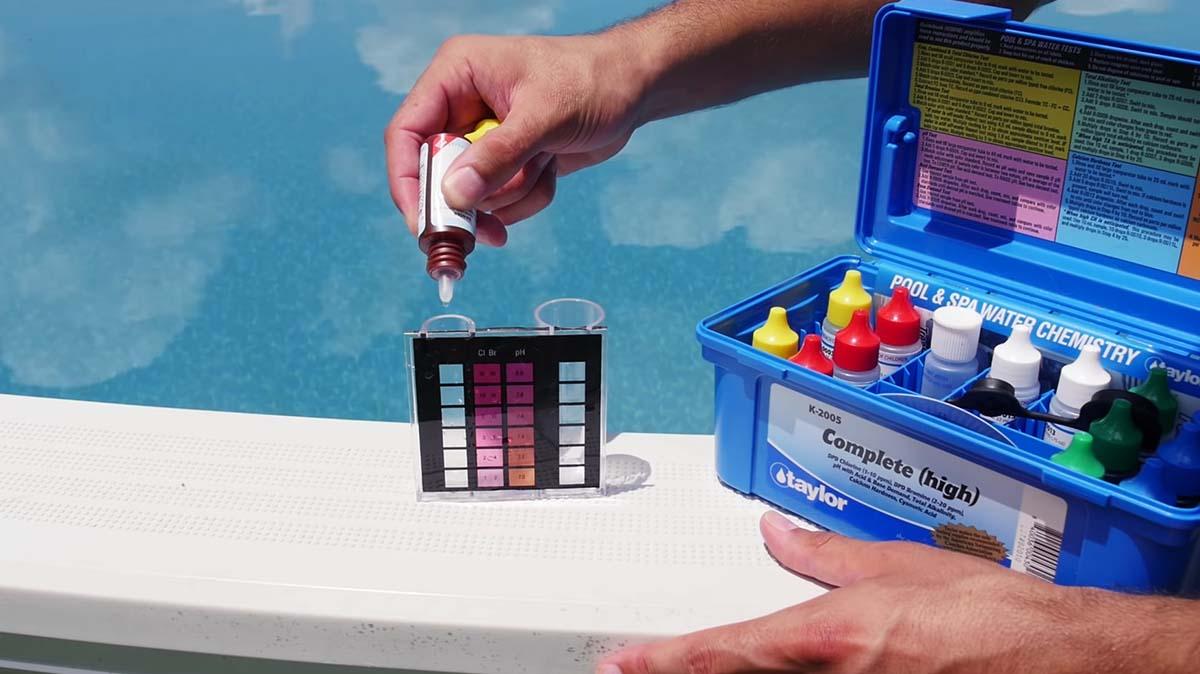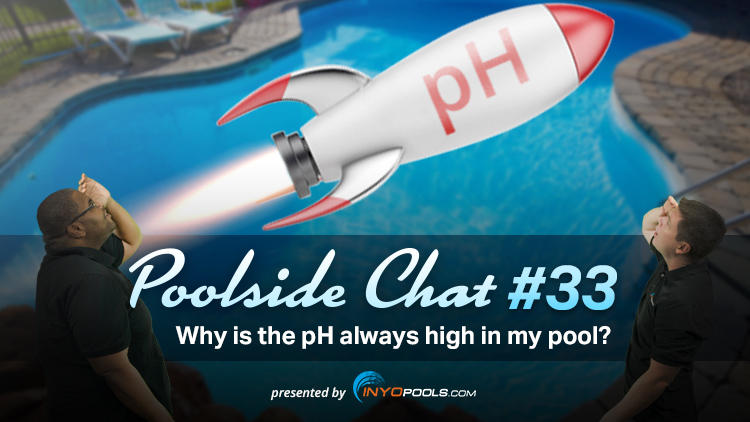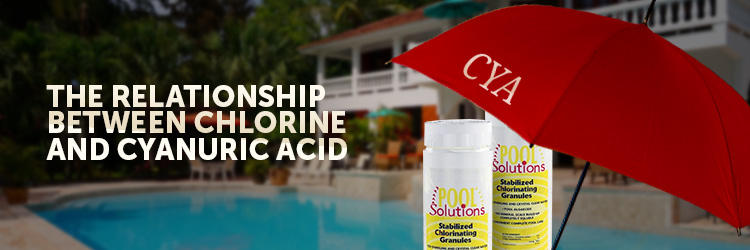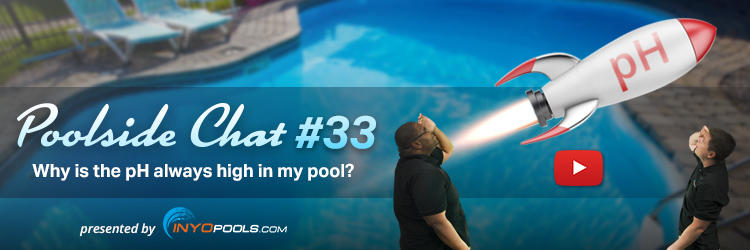
Pool Water Chemistry
Troubleshooting
Resources for fixing your water chemistry problems.

Tip: Maintaining proper water chemistry is vital for a safe and enjoyable swimming experience. Regularly test your pool water for pH, alkalinity, and chlorine levels to ensure they are within the recommended ranges. Adjust chemicals as needed to prevent algae growth, eye irritation, and equipment corrosion. Balanced water chemistry not only protects swimmers but also extends the life of your pool and its components, ensuring a clean and inviting environment all season long.
Common Water Chemistry Problems
Click on a symptom that you are experiencing…
Cloudy Water
Problem:
Cloudy water in your pool can be a sign of various issues, including poor filtration, imbalanced water chemistry, or the presence of contaminants. Not only does cloudy water detract from the aesthetic appeal of your pool, but it can also indicate potential health risks if not addressed promptly.
Action Items:
- Test water chemistry: Use a reliable pool water testing kit to check for pH, alkalinity, chlorine, and other chemical levels. Imbalanced water can contribute to cloudiness, so ensure all parameters are within the recommended ranges.
- Shock the pool: If chlorine levels are low or organic contaminants are present, shocking the pool can help clear cloudy water. Follow the manufacturer’s instructions for the correct dosage and method.
- Clean or replace the filter: A dirty or malfunctioning filter may not effectively remove particles from the water. Clean the filter according to the manufacturer’s recommendations, or replace it if it’s damaged.
- Vacuum the pool: Manually vacuuming the pool can help remove debris and contaminants that may be causing cloudiness. Focus on corners and areas where debris tends to accumulate.
- Increase circulation: Ensure your pool’s circulation system is operating effectively. Running the pump for longer periods can help distribute chemicals and clear cloudy water more efficiently.
Green Pool (Algae Growth)
Problem:
A green pool is typically a sign of algae growth, which can occur due to insufficient sanitization, poor water circulation, or imbalanced water chemistry. Algae not only affects the aesthetic of your pool but can also create slippery surfaces and pose health risks.
Action Items:
- Shock the pool: Use a chlorine shock treatment to kill the algae. Follow the manufacturer’s instructions for the correct dosage based on your pool size.
- Brush the pool surfaces: After shocking, use a pool brush to scrub the walls, steps, and floor to dislodge algae. This will help the chlorine reach and kill the algae more effectively.
- Test and adjust water chemistry: Check the pH and alkalinity levels. Ideally, pH should be between 7.2 and 7.6. Adjust as needed to create an environment that is less favorable for algae growth.
- Run the filter continuously: Keep your pool filter running 24/7 until the water clears. This helps remove dead algae and other debris from the water.
- Use algaecide: Consider adding an algaecide as a preventive measure once the pool is clear. Regular use can help prevent future algae blooms.
Corrosion of Pool Equipment
Problem:
Corrosion of pool equipment can occur due to prolonged exposure to pool chemicals, improper water balance, or environmental factors such as humidity and temperature. Corroded equipment can lead to leaks, reduced efficiency, and increased maintenance costs, making it essential to address the issue promptly.
Action Items:
- Inspect equipment regularly: Conduct regular visual inspections of all pool equipment, including pumps, filters, heaters, and metal components, to identify any signs of corrosion early on.
- Maintain proper water chemistry: Ensure that your pool water is balanced, particularly pH and alkalinity levels, to minimize corrosion risks. Aim for a pH between 7.2 and 7.6 and appropriate alkalinity levels.
- Use corrosion-resistant materials: Consider upgrading to corrosion-resistant equipment, such as plastic or stainless steel components, especially if your pool is in a harsh chemical environment.
- Apply protective coatings: Use protective coatings on metal parts to shield them from corrosive elements. Regularly reapply these coatings as needed to maintain protection.
- Drain and clean the pool system: Periodically drain your pool and clean the equipment to remove buildup and contaminants that can contribute to corrosion.
Scaling or Deposits on Surfaces
Problem:
Scaling or deposits on pool surfaces are often a result of high calcium hardness, elevated pH levels, or improper water balance. These deposits can not only detract from the appearance of your pool but also create rough surfaces that may lead to further cleaning challenges and even damage to pool equipment.
Action Items:
- Test water hardness: Use a water testing kit to check the calcium hardness levels. Ideally, calcium hardness should be maintained between 200 and 400 ppm. If levels are too high, consider diluting the pool water with fresh water.
- Adjust pH levels: Maintain the pH between 7.2 and 7.6. High pH levels can contribute to scaling, so adjusting this can help minimize deposits.
- Use a sequestering agent: Adding a sequestering agent can help dissolve existing calcium deposits and prevent new scaling from forming. Follow the manufacturer’s instructions for the correct dosage.
- Brush and clean surfaces: Regularly brushing the pool surfaces can help remove scale buildup. Use a pool brush designed for your pool type to prevent damage.
- Increase water circulation: Ensure your pool’s circulation system is functioning effectively. Improved circulation can help distribute chemicals evenly and prevent localized scaling.
Skin and Eye Irritation
Problem:
Skin and eye irritation in pool users can be caused by a variety of factors, including imbalanced water chemistry, high levels of chlorine, or the presence of contaminants in the water. Addressing these issues is crucial for ensuring a safe and enjoyable swimming experience.
Action Items:
- Test water chemistry regularly: Use a reliable pool water testing kit to monitor pH, chlorine levels, and other chemical balances. Aim for a pH level between 7.2 and 7.6 and ensure that chlorine levels are within the recommended range (1-3 ppm for free chlorine).
- Shock the pool: If chlorine levels are low or contaminants are present, shocking the pool can help eliminate irritants. Follow the manufacturer’s instructions for the appropriate dosage based on your pool size.
- Increase water circulation: Ensure that your pool’s filtration system is running effectively. Proper circulation helps remove debris and contaminants that can cause irritation.
- Use a pool conditioner: Consider using a pool conditioner or stabilizer to help protect chlorine from degradation and maintain effective levels that minimize irritation.
- Encourage pre-swim hygiene: Remind swimmers to shower before entering the pool to remove personal care products, dirt, and oils that can contribute to irritation.
Strong Chlorine Odor
Problem:
A strong chlorine odor often indicates an imbalance in pool chemistry, particularly related to the levels of combined chlorine (chloramines). When chlorine reacts with contaminants like sweat, urine, and organic debris, it forms chloramines, which not only create the strong smell but can also lead to skin and eye irritation. Addressing this issue is essential for maintaining a safe swimming environment.
Action Items:
- Test and adjust chlorine levels: Regularly test the pool water to check for free and combined chlorine levels. Aim for free chlorine levels between 1-3 ppm. If combined chlorine levels are high, it may be time to shock the pool.
- Shock the pool: Shocking the pool can help break down chloramines and reduce the chlorine smell. Follow the manufacturer’s instructions for the correct dosage based on your pool size and current chlorine levels.
- Improve water circulation: Ensure that your pool’s filtration system is working effectively. Proper circulation helps distribute chlorine evenly and remove contaminants that contribute to odor.
- Encourage swimmer hygiene: Promote showering before swimming to reduce the amount of organic matter introduced into the pool, which can lead to chloramine formation.
- Consider using a non-chlorine shock: In addition to traditional chlorine shock, using a non-chlorine shock can help eliminate chloramines without increasing chlorine levels, reducing odor effectively.
Stained Surfaces
Problem:
Stained surfaces in a pool can be caused by various factors, including mineral deposits, organic materials, or chemical imbalances. Common culprits for staining include metals (like iron or copper) in the water, leaves, and other organic debris. These stains can detract from the pool’s appearance and may require specific treatments to remove effectively.
Action Items:
- Identify the stain type: Determine the source of the stains. Common stains include rust (from metal), green or black spots (from algae or organic materials), and brown or gray stains (from calcium deposits). Identifying the type will help in choosing the right treatment.
- Test water chemistry: Regularly test your pool water for pH, alkalinity, and metal levels. Ensure that pH is maintained between 7.2 and 7.6, as improper balance can contribute to staining.
- Use a stain remover: Depending on the stain type, consider using a pool stain remover specifically designed for the material causing the stain (e.g., metal stain removers for rust or algae stain removers). Follow the manufacturer’s instructions for application.
- Brush and vacuum: Regularly brushing stained areas can help loosen deposits, making them easier to remove. Follow up by vacuuming the pool to eliminate debris and any loosened stains.
- Prevent future stains: Maintain proper water balance, regularly clean the pool, and remove organic debris promptly. Consider using a metal sequestrant if metal staining is a recurring issue.
Foamy Water
Problem:
Foamy water in a pool can be an indication of an imbalance in water chemistry, often resulting from the presence of organic contaminants, high levels of surfactants, or inadequate filtration. The foam can be unsightly and may indicate that the pool requires maintenance to ensure a clean and safe swimming environment.
Action Items:
- Test water chemistry: Regularly check the water for pH, alkalinity, and chlorine levels. Maintain pH between 7.2 and 7.6 and ensure proper sanitizer levels. High levels of total dissolved solids (TDS) can also contribute to foaming.
- Shock the pool: If contaminants are present, shocking the pool can help break down organic matter and reduce foam. Follow the manufacturer’s instructions for dosage and application.
- Clean the filter: Ensure your pool’s filtration system is functioning properly. A dirty or clogged filter can fail to remove organic debris, leading to foaming. Clean or backwash the filter as needed.
- Brush and vacuum the pool: Regularly brushing the walls and floor can help remove contaminants that contribute to foam. Follow up by vacuuming to ensure all debris is eliminated.
- Consider using an anti-foam product: If foaming persists, you may want to consider adding an anti-foam agent specifically designed for swimming pools. Use it according to the manufacturer’s instructions.
Unstable Water Balance
Problem:
An unstable water balance in your pool can lead to various issues, including cloudy water, staining, and irritation for swimmers. Common causes of unstable water balance include fluctuating pH and alkalinity levels, high total dissolved solids (TDS), and inadequate sanitization. Regular monitoring and adjustments are essential for maintaining a safe and enjoyable swimming environment.
Action Items:
- Regularly test water chemistry: Use a reliable pool testing kit to frequently check pH, alkalinity, and chlorine levels. Aim for a pH range of 7.2 to 7.6, total alkalinity between 80-120 ppm, and free chlorine levels of 1-3 ppm.
- Adjust pH and alkalinity: If your tests show imbalances, use pH increaser (sodium carbonate) to raise pH or pH decreaser (sodium bisulfate) to lower it. Adjust total alkalinity with sodium bicarbonate to raise it or muriatic acid to decrease it.
- Monitor and reduce TDS levels: High TDS can lead to imbalances. If TDS levels exceed 1500 ppm, consider partially draining the pool and refilling it with fresh water to dilute the concentration.
- Ensure proper filtration: A well-maintained filtration system helps keep the water clean and balanced. Regularly clean or replace filter media as needed to ensure optimal performance.
- Implement a regular maintenance schedule: Establish a routine for testing and adjusting water chemistry, cleaning the pool, and maintaining the filtration system. Consistency is key to achieving stable water balance.











